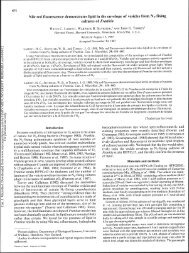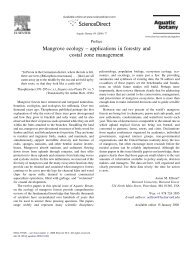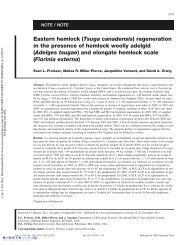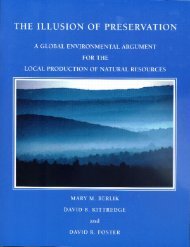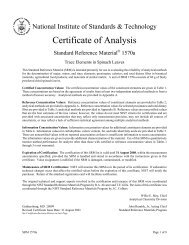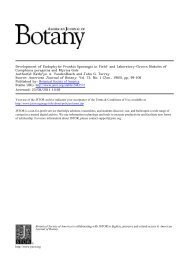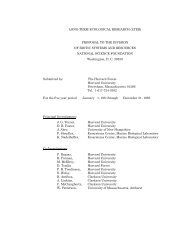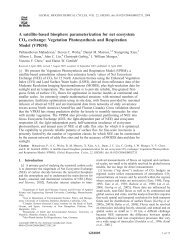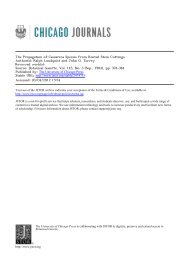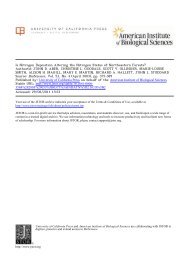Abstracts of Papers - Harvard Forest - Harvard University
Abstracts of Papers - Harvard Forest - Harvard University
Abstracts of Papers - Harvard Forest - Harvard University
You also want an ePaper? Increase the reach of your titles
YUMPU automatically turns print PDFs into web optimized ePapers that Google loves.
ent dominants. Monitoring during the ensuing 20<br />
years recorded the spread <strong>of</strong> Typha, changes in<br />
density and productivity <strong>of</strong> other dominants, and<br />
minor shifts in understory species. Analysis <strong>of</strong><br />
alterations in species composition can be used to<br />
predict vegetation responses after flooding in<br />
similar marshes. Phragmites, Typha, Scirpus and<br />
Scolochloa life cycle characteristics and biomass<br />
have been monitored in a number <strong>of</strong> sites. Variations<br />
between sites and years will be compared with data<br />
from a transect from lat 51?N to lat 56?N.<br />
VAN DER VALK, ARNOLD G. Department <strong>of</strong> Botany,<br />
Iowa State <strong>University</strong>, Ames, IA 50011.<br />
- Vegetation dynamics in freshwater wetlands.<br />
Vegetation change in freshwater wetlands will be<br />
reviewed as well as theories put forth to explain<br />
it. This review will focus on two basic questions:<br />
(1) What are the mechanisms that enable the<br />
establishment and persistence <strong>of</strong> wetland vegetation?<br />
(2) What are the mechanisms that cause the com-<br />
position and structure <strong>of</strong> wetland vegetation to<br />
change? A new model is presented in which all<br />
vegetation change is due to one <strong>of</strong> three phenomena<br />
or a combination <strong>of</strong> them: Gleasonian succession,<br />
maturation, and fluctuation. These three phenomena<br />
are defined and then illustrated using data from<br />
prairie glacial marshes.<br />
Poster Session<br />
AARSSEN* LONNIE W. & ROY TURKINGTONo Botany Dept.,<br />
<strong>University</strong><br />
V6T 2B1.<br />
<strong>of</strong> British Columbia, Vancouver, B.C.<br />
- Temporal vegetation patterns in three different<br />
aged pastures.<br />
Three adjacent pastures (planted in 1977, 1958 and<br />
1939) on a farm in the lower Fraser Valley <strong>of</strong> British<br />
Columbia were surveyed periodically over a 3 year<br />
period. In each survey, species cover was recorded<br />
in quadrats and contact sampling was used to investigate<br />
temporal patterns <strong>of</strong> fine-scale association<br />
between species. Ordination <strong>of</strong> time-series percentage<br />
cover surveys showed a trend <strong>of</strong> increasing community<br />
constancy in older pastures and suggested that<br />
the three communities have a developmental relationship.<br />
Soil analyses showed little correlation with<br />
species cover and the fewest correlations in the<br />
oldest pasture. Interspecific associations in<br />
younger communities were predominantly temporary in<br />
nature while older communities had more associations<br />
which persisted essentially unchanged. This data<br />
formed the basis <strong>of</strong> a qualitative model <strong>of</strong> pasture<br />
community evolution which attributes within-community<br />
temporal changes to the selective forces accruing<br />
from biotic interactions.<br />
ATKINS, TREVOR A.** Dept. <strong>of</strong> Botany, U. <strong>of</strong> Manitoba,<br />
Winnipeg, Manitoba, R3T 2N2; PETER F. LEE, Dept. <strong>of</strong><br />
Biology, Lakehead U., Thunder Bay, Ontario, P7B 5E1;<br />
JOHN M. STEWART, Dept. <strong>of</strong> Botany, U. <strong>of</strong> Manitoba,<br />
Winnipeg, Manitoba, R3T 2N2.<br />
-Environmental interactions influencing the growth<br />
and development <strong>of</strong> Zizania aquatica.<br />
Two sites on Lake <strong>of</strong> the Woods, Ontario were monitored<br />
Ecological Section 41<br />
bi-weekly in the summer <strong>of</strong> 1982. Wild rice growth<br />
(density, biomass, phenophase) and tissue nutrition (9<br />
elements) were measured through sampling in randomized<br />
complete block experiments. Water depth was used as a<br />
blocking factor in both sites: One site also included<br />
blocking on the presence <strong>of</strong> lily pad (Nuphar) competit-<br />
ion. The physical environments <strong>of</strong> the two sites were<br />
monitored for water depth, water column temperature and<br />
dissolved oxygen concentration pr<strong>of</strong>iles; and soils for<br />
pH, conductivity, bulk density and nutrient regime.<br />
Biomass, density, and nutrient contents <strong>of</strong> competing<br />
macrophytes were also measured. The growth and devel-<br />
opment <strong>of</strong> the wild rice population was then related<br />
to its physical environment through multi-variate<br />
analysis. Growth was found to be influenced by enviro-<br />
mental factors common to other studies. The previously<br />
unexplored interactions amongst variables yielded<br />
inLsight into the growth and development <strong>of</strong> wild rice.<br />
Interactions with oxygen are <strong>of</strong> significant interest.<br />
BARNES, FAIRLEY J.*, and GARY L CUNNINGHAM. Dept.<br />
Biology, New Mexico State <strong>University</strong>, Las Cruces,<br />
NM 88003. - Water status <strong>of</strong> dominant species in<br />
pinyon-juniper habitat types.<br />
Pinus edulis and Juniperus monosperma have overlapping<br />
distributions in the pinyon-juniper woodland <strong>of</strong><br />
northern New Mexico. Forty sites representing the<br />
range <strong>of</strong> pinyon-juniper habitats in the Jemez<br />
Mountains were analyzed using vegetative and physical<br />
site characteristics. Three habitat types (HT) were<br />
distinguishable primarily on the densities <strong>of</strong> mature<br />
and seedling P. edulis and J. monosperma, and<br />
secondarily on the presence <strong>of</strong> specific perennial<br />
grasses. Sites within each HT were ranked using the<br />
same criteria and six sites selected to form a<br />
presumptive moisture gradient characteristic <strong>of</strong> the<br />
woodland. Predawn leaf water potentials <strong>of</strong> P. edulis<br />
and J. monosperma did not vary significantly among<br />
the sites. This may indicate that these dominant<br />
trees are occupying microsites <strong>of</strong> favorable moisture<br />
and that their densities within the various HT's are<br />
a reflection <strong>of</strong> the availability <strong>of</strong> such microsites.<br />
BIGLEY, RICHARD E. and PAUL G. HARRISON*. Depart-<br />
ment <strong>of</strong> Botany, <strong>University</strong> <strong>of</strong> British Columbia,<br />
Vancouver, B.C., Canada V6T 2B1. - The population<br />
biology <strong>of</strong> two intertidal seagrasses, Zostera<br />
japonica and Ruppia maritima, at Roberts Bank,<br />
British Columbia.<br />
Vegetative and flowering components <strong>of</strong> co-occurring<br />
intertidal populations <strong>of</strong> Zostera japonica Ascherson<br />
and Graebner (a recent introduction) and Ruppia<br />
maritima L. s.l. (more commonly found in inland<br />
brackish water) were studied in southwestern British<br />
Columbia. Results from one year <strong>of</strong> repeated mapping<br />
and examination <strong>of</strong> shoots in permanent plots on a<br />
tidal gradient showed that shoot flux, age structure,<br />
survivorship, growth <strong>of</strong> leaves and rhizomes, and seed<br />
production all were affected by the amount <strong>of</strong> expos-<br />
ure to the air. Plots having the greatest exposure<br />
had fewer shoots (<strong>of</strong> both species), a greater percent<br />
<strong>of</strong> shoots flowering early in the season, and lower<br />
seed production than plots with less exposure. The<br />
length <strong>of</strong> the life cycle <strong>of</strong> R. maritima was the same<br />
regardless <strong>of</strong> differences in exposure, while plants<br />
<strong>of</strong> Z. japonica subject to the longest exposure to the<br />
air initiated and ended flowering and entered a qui-<br />
escent overwintering state earlier than plants lower<br />
in the intertidal zone.




